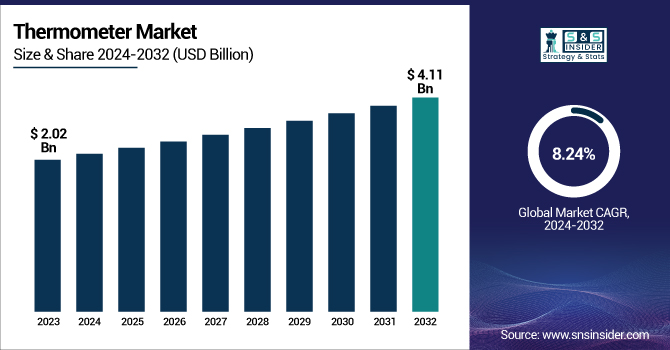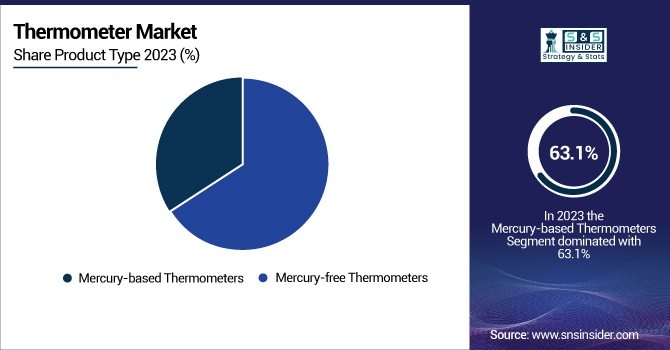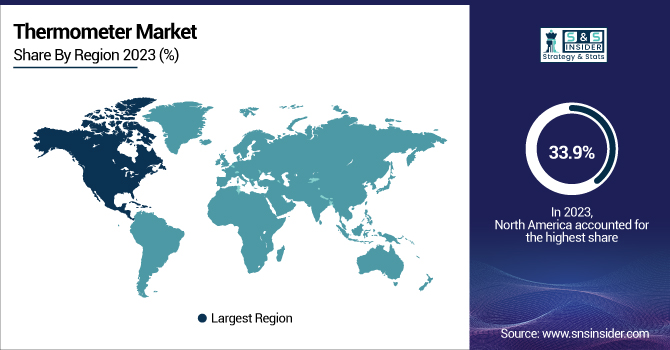Global Thermometer Market Overview:
The Thermometer Market Size was valued at USD 2.02 Billion in 2023 and is expected to reach USD 4.11 Billion by 2032 and grow at a CAGR of 8.24% over the forecast period 2024-2032.

To Get more information on Thermometer Market - Request Free Sample Report
This report identifies the increasing incidence and prevalence of fever conditions, fueling the need for advanced temperature-measuring devices. The research examines trends in innovation, such as the creation of smart and AI-based thermometers that provide real-time monitoring, mobile app connectivity, and improved accuracy. It also explores changing consumer attitudes, where heightened health consciousness and convenience are shaping purchasing behavior, with more preference for contactless infrared thermometers and digital ones over the traditional mercury-based types. The influence of e-commerce is also explored, as online channels continue to increase product availability and shape purchasing behavior.
Market Dynamics
Drivers
-
Growing Demand for Accurate and Contactless Temperature Monitoring
The growth in the thermometers market is fueled by heightened health awareness, growing infectious diseases, and expanding use of digital and infrared thermometers. Due to the growing number of fever-related illnesses such as influenza, COVID-19, and dengue, the sale of precise and contactless thermometers has accelerated sharply. During the COVID-19 pandemic, for example, sales of infrared thermometers accelerated worldwide by more than 300% as they became widely used in public places, workplaces, and hospitals. Moreover, innovation in smart thermometers with Bluetooth and app connectivity, like Kinsa Smart Thermometers, has transformed personal healthcare by allowing real-time tracking of data. The increasing trend of remote patient monitoring has also supported market growth, as healthcare providers increasingly prescribe smart thermometers for home healthcare. In addition, government regulations against mercury thermometers in many nations to address environmental and health issues have created consumer demand for mercury-free digital thermometers. Applications outside the healthcare sector, including food safety and HVAC (heating, ventilation, and air conditioning) industries, have also contributed to thermometer use for regulatory purposes. The growing use of AI-based temperature sensors in medical and industrial sectors also drives the market. In total, the need for accurate, non-invasive, and intelligent thermometers will increase, supporting the market's long-term growth prospects.
Restraints
-
High Cost of Advanced Thermometers and Lack of Awareness in Developing Regions
Even with robust market growth, the prohibitive cost of advanced thermometers is a primary constraint, holding back their adoption, particularly in price-sensitive markets. Smart and infrared thermometers, which provide quick and non-contact temperature readings, can be 2-3 times more expensive than conventional digital thermometers. This price difference renders them less affordable in low-income countries, where mercury or simple digital thermometers are still in widespread use. Moreover, the low awareness and accessibility in rural and underdeveloped regions limit market penetration. Numerous consumers are not aware of the advantages of infrared and intelligent thermometers, which results in sustained use of older mercury-based devices even after regulatory prohibitions. Accuracy issues with non-contact thermometers are another restraint. Research has indicated that infrared thermometers may occasionally provide inconsistent readings as a result of environmental conditions like humidity and changes in ambient temperatures. Additionally, restricted battery life and maintenance problems with digital thermometers present further issues, necessitating constant replacement or recalibration. Some medical professionals are also wary of the validity of ear and forehead thermometers, opting instead for conventional oral or rectal thermometers to obtain accurate results. These all contribute to preventing market growth, especially in areas where affordability and accessibility are key impediments.
Emerging Opportunities in the Thermometer Industry
-
The thermometer market is witnessing significant opportunities driven by technological advancements and expanding applications beyond healthcare.
Technologies like AI-enabled thermometers, temperature sensors that can be worn, and IoT-enabled smart thermometers are transforming temperature measurement. Smart thermometers like the Withings Thermo offer real-time monitoring, remote sharing of data, and fever pattern analysis, improving consumer and healthcare usability. Moreover, the increasing use of non-contact thermometers in food safety, industrial monitoring, and veterinary medicine is creating new revenue opportunities. For example, the food industry more widely employs infrared thermometers to achieve safety compliance with regulations, achieving proper storage and cooking temperatures. The HVAC industry depends similarly on digital thermometers for the efficiency of systems and management of energy. The growth of telemedicine and remote monitoring of healthcare is another significant opportunity. With the growth of virtual healthcare, there is growing demand for networked thermometers that are able to connect with mobile apps and with hospital systems. Moreover, government programs promoting public health sensitivity and medical equipment funding in educational institutions, places of work, and public areas further fuel the market potential. The growing integration of e-commerce platforms is increasingly making sophisticated thermometers available across global consumers as well. Due to ongoing developments and expanding fields of application, the thermometer industry is expected to experience steady expansion across various categories.
Challenges Facing the Thermometer Market
-
One of the biggest challenges in the thermometer market is the proliferation of counterfeit products, which affects consumer trust and brand reputation.
The market has witnessed an increase in low-quality, unregulated thermometers, especially in online stores. Most of these devices give false readings, do not have required regulatory approvals (e.g., FDA and CE certifications), and are unsafe. Research shows that as much as 30% of non-contact infrared thermometers available in some markets might not be of medical-grade accuracy. This results in misdiagnosis and impacts the credibility of digital thermometers in the healthcare sector. Another hurdle is compliance with regulations since countries have diverse requirements on the accuracy and safety of thermometers. The companies have to deal with complicated certification procedures to attain universal standards of quality, thus adding costs of production and market entry hurdles. Furthermore, there is still competition from conventional thermometers in poor countries where mercury thermometers continue to be utilized even when banned. Another constant issue is sensor calibration and data validity in digital and intelligent thermometers, as fluctuations in environmental conditions can influence performance. In the absence of proper regulation and public education, the market has problems ensuring product uniformity, consumer trust, and mass use of sophisticated thermometer technology.
Thermometer Market Segmentation Analysis
Thermometer Market By Product Type
The mercury-free thermometers segment led the market in 2023, holding the highest revenue share of 63.1%. Increased knowledge of the environmental and health risks posed by mercury, as well as the imposition of strict laws prohibiting or limiting the use of mercury-based thermometers in most nations, was a key driver of this leadership. Furthermore, the heightened usage of digital and infrared thermometers in both medical and non-medical use also boosted demand for mercury-free products.
The mercury-free thermometers category is also anticipated to be the fastest-growing segment in the forecast period. The fast transition towards safer, more precise, and environmental-friendly temperature measurement solutions has impelled widespread adoption. The increase in demand for digital and infrared thermometers for use in healthcare, food safety, and industry has further spurred market growth.

Thermometer Market by Application
The Medical segment was the largest revenue generator in 2023, with a market share of 27.1%. The growing incidence of infectious diseases, higher hospital visits, and extensive use of thermometers in home care environments were major drivers of this dominance. Moreover, the post-COVID-19 pandemic period maintained the demand for precise and non-contact temperature monitoring equipment, supporting the segment's market leadership.
The industrial sector is likely to witness the maximum growth rate over the forecast period. The growing requirement for temperature measurement in manufacturing, HVAC, and energy industries has propelled the demand for sophisticated industrial thermometers. In addition, stringent safety and quality control regulations in industries like pharmaceuticals, automotive, and metallurgy have promoted the use of infrared and digital thermometers in industries.
Regional Insights
North America Thermometer Market Trends
North America accounted for 33.9% of total revenues in the global thermometer market in 2023, which is due to well-developed healthcare infrastructure, high disease prevention awareness, and mass utilization of digital and infrared thermometers. The leading country in the market was the United States because of the growing requirement for home-use thermometers, common flu outbursts, and government policies favoring mercury-free devices. The availability of industry leaders like Braun, Exergen, and Kinsa further enhanced the market position of the region. Moreover, the accessibility of thermometers from retail pharmacies, online websites, and hospital supply chains has increased accessibility and sales.
Asia-Pacific Thermometer Market Growth
Europe accounted for a high market share due to stringent regulatory policies prohibiting mercury thermometers, increasing healthcare costs, and an increasing demand for sophisticated temperature-measuring devices. Concurrently, the Asia-Pacific (APAC) region was the fastest-growing with China, India, and Japan driving growth. The mounting demand for thermometers in hospitals, home healthcare, and industrial uses has been a key driver. In addition, initiatives from the government to enhance public health infrastructure, outbreaks of diseases, and growth in online and offline retailing channels have driven the sale of thermometers. Growing demand for smart and non-contact infrared thermometers is a key trend that will form the future dynamics of the regional market.

Get Customized Report as per Your Business Requirement - Enquiry Now
Key Thermometer Market Players and Products
-
Medline Industries, Inc. – Medline Digital Oral Thermometer, Medline No-Touch Forehead Thermometer
-
Welch Allyn – Welch Allyn SureTemp Plus 690, Welch Allyn Braun ThermoScan PRO 6000
-
Medtronic – Covidien Genius 3 Tympanic Thermometer
-
OMRON Corporation – OMRON MC-720 Infrared Forehead Thermometer, OMRON Eco Temp Digital Thermometer
-
American Diagnostics Corporation (ADC) – ADC Adtemp 429 Non-Contact Infrared Thermometer, ADC Adtemp 413 Digital Stick Thermometer
-
3M Company – 3M Tempa•DOT Disposable Thermometers
-
Microlife Corporation – Microlife NC 200 Non-Contact Thermometer, Microlife MT 850 Digital Thermometer
-
Briggs Healthcare – HealthSmart Digital Thermometer, HealthSmart Non-Contact Infrared Thermometer
-
Exergen Corporation – Exergen Temporal Artery Thermometer TAT-5000, Exergen Smart Glow Thermometer
-
Terumo Corporation – Terumo Digital Thermometer C202, Terumo Electronic Thermometer ET-C232P
Recent Developments in the Thermometer Industry
-
In March 2025, Govee reduced the price of its WiFi Hygrometer Thermometer Sensor (3-Pack), now available for under USD 19 per unit. This price drop enhances affordability for consumers seeking smart temperature and humidity monitoring solutions.
-
In May 2022, Exergen Corporation introduced the TAT-2000 Temporal Artery Thermometer, which is specifically tailored for the Indian market, at the Medical Fair in Mumbai. The company specializes in non-invasive temperature measurement instruments, providing greater accuracy, cost-effectiveness, and ease of use while providing greater reliability.
| Report Attributes | Details |
|---|---|
| Market Size in 2023 | USD 2.02 billion |
| Market Size by 2032 | USD 4.11 billion |
| CAGR | CAGR of 8.24% From 2024 to 2032 |
| Base Year | 2023 |
| Forecast Period | 2024-2032 |
| Historical Data | 2020-2022 |
| Report Scope & Coverage | Market Size, Segments Analysis, Competitive Landscape, Regional Analysis, DROC & SWOT Analysis, Forecast Outlook |
| Key Segments | • By Product [Mercury-based Thermometers, Mercury-free Thermometers (Infrared Radiation Thermometers, Digital Thermometers, Others)] • By Application [Medical, Industrial, Food, Laboratory, Others] |
| Regional Analysis/Coverage | North America (US, Canada, Mexico), Europe (Eastern Europe [Poland, Romania, Hungary, Turkey, Rest of Eastern Europe] Western Europe] Germany, France, UK, Italy, Spain, Netherlands, Switzerland, Austria, Rest of Western Europe]), Asia Pacific (China, India, Japan, South Korea, Vietnam, Singapore, Australia, Rest of Asia Pacific), Middle East & Africa (Middle East [UAE, Egypt, Saudi Arabia, Qatar, Rest of Middle East], Africa [Nigeria, South Africa, Rest of Africa], Latin America (Brazil, Argentina, Colombia, Rest of Latin America) |
| Company Profiles | Medline Industries, Inc., Welch Allyn, Medtronic, OMRON Corporation, American Diagnostics Corporation (ADC), 3M Company, Microlife Corporation, Briggs Healthcare, Exergen Corporation, Terumo Corporation. |

